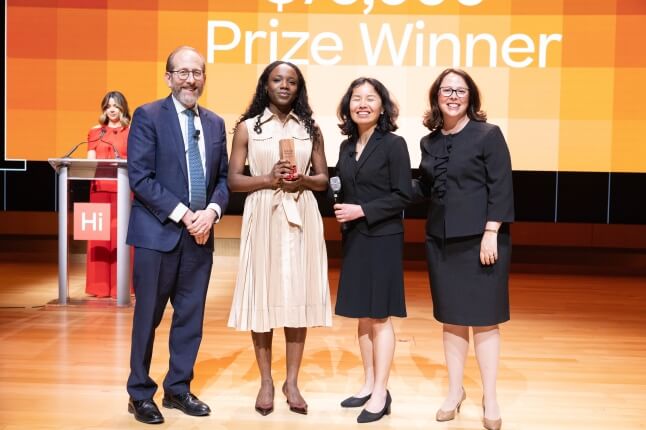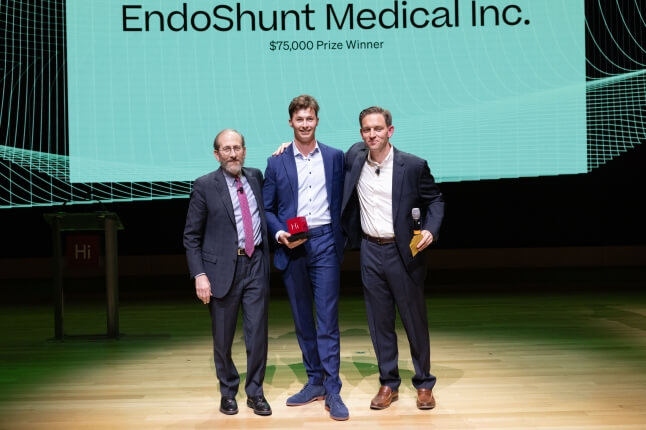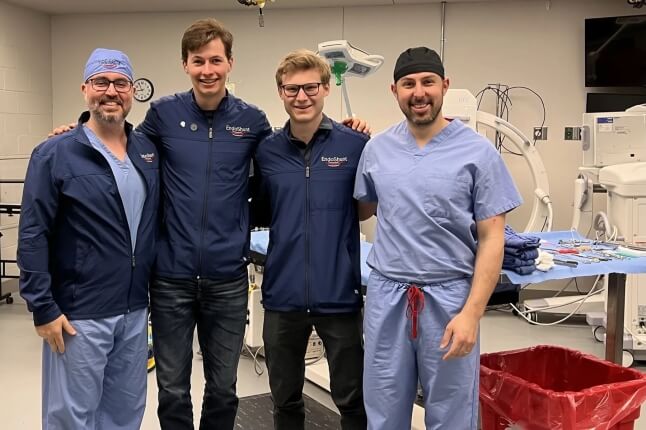News
MS/MBA students Noah Zweben and Elena Horton present Project HOPE at the Technology Showcase at the Science and Engineering Complex. (Evgenia Eliseeva/HBS)
Systems thinking is critical to the educational approach at the Harvard John A. Paulson School of Engineering and Applied Sciences (SEAS). Engineering students don’t just learn how to build a microchip or code a computer program – they learn how to define a problem, identify the different groups affected by the problem, then devise a solution that maximizes the benefit to as many stakeholders as possible.
This approach can be applied to new business ventures, as was demonstrated at the recent Technology Showcase for two programs co-run by SEAS and the Harvard Business School (HBS): the MS/MBA: Engineering Sciences graduate program, and the Undergraduate Technology Innovation Fellows Program, supported by the Roberts Family Foundation and co-organized by SEAS, HBS and the Harvard Faculty of Arts and Sciences.
Projects presented at the event at the Science and Engineering Complex included using artificial intelligence to help address homelessness, more affordable STEM education opportunities in Malaysia, and a social media app that enables broader engagement with political conversations.
“It’s an educational intersection between applied science and business, but also an intersectional approach to systems thinking,” said Hanspeter Pfister, An Wang Professor of Computer Science and co-chair of the Harvard Undergraduate Technology Innovation Fellows Program. “The engineering approach to design has a lot to teach.”
Harvard Undergraduate Technology Innovations Fellows Program co-chairs Hanspeter Pfister, An Wang Professor of Computer Science at SEAS, and Tom Eisenmann, Howard H. Stevenson Professor of Business Administration at Harvard Business School and Co-Chair of the MS/MBA: Engineering Sciences program, at the Technology Showcase at the Science and Engineering Complex. (Evgenia Eliseeva/SEAS)
Noah Zweben, M.S./M.B.A. ‘23, used a systems framework when developing Project HOPE: Homelessness Outreach Planning Effort. By training an AI to read existing data on rough sleepers – individuals sleeping on streets, in urban tents and cars – Zweben hopes to help outreach coordinators determine how best to deploy their limited frontline support personnel.
“It started with connecting with outreach workers and asking what problems they’re facing,” Zweben said. “There’s a huge focus on brainstorming and then validating your ideas. There are all these crucial problems we face around democracy, environment and climate, and all the solutions exist at this really interesting intersection of technological complexity and business complexity.”
Roberts Family Fellow Zad Chin, a third-year computer science and math concentrator, created Logic X Labs through a similar process. She defined a clear problem, which is that computer science education is often too expensive for low-income families in her native Malaysia, then began to program an AI chatbot that could debug code and answer questions, potentially reducing the need for expensive tutors.
"I learned how to formulate a problem statement and testing strategy, and we’re going to run a pilot program in Malaysia this summer,” Chin said. “The Fellows have so many different passions. Learning about what they’re passionate about really helped me to widen my perspective on what technology can really do and how it can be combined with business.”
Roberts Family Fellow Zad Chin presents her start-up Logic X Labs at the Technology Showcase at the Science and Engineering Complex. (Evgenia Eliseeva/HBS)
Roberts Family Fellow Palis Pisuttisarun kicked off the presentation portion of the evening with two applications he developed before becoming a Fellow: Prism Chat, a support network and safe chatting space for marginalized communities such as LGBTQ+ and the neurodivergent, and Trayne, which presents political conversations as a branching set of railroad tracks. As a fellow, he has been able to apply many of the principles he learned to Trayne.
“We had a recent design workshop where we learned about formulating problem statements and creating solutions that addressed needs expressed in user interviews,” Pisuttisarun said. “We have ideas all the time, so having the toolkit to evaluate what’s worth pursuing is really valuable.”
Programs like the MS/MBA and Undergraduate Technology Innovation Fellows Program don’t just enable new ventures – they also provide the tools to quickly change a venture when the initial idea stops being viable. When Roberts Family Fellow Michael Wu presented Coolant last spring, the start-up was a marketplace to allow investment in carbon credits. Carbon credits are supposed to fund decarbonization efforts through planting forests or building wind turbines, but when recent news coverage began to call their effectiveness into question, Wu switched his start-up to supplying high-quality credits that actually offset carbon emissions.
“We’re problem solvers at the end of day,” Wu said.
Paul Hayre, Executive Director for the Harvard Grid, addresses students at the Technology Showcase for MS/MBA students and the Undergraduate Technology Innovation Fellows Program at the Science and Engineering Complex. (Evgenia Eliseeva/HBS)
This was the first showcase for the two programs since the launch of the Harvard Grid. A collaboration between SEAS and the Harvard Office of Technology Development, the Grid enables researchers to translate their lab innovations into commercially viable products and services. The Grid connects researchers with funding, research space, mentorship and educational programming, tapping into resources that already exist at Harvard and also bringing in outside industry experts.
The Undergraduate Innovation Technology Fellows Program and MS/MBA, which already exist at the intersection of technology and entrepreneurship, are two perfect examples of programs that will benefit from what the Grid has to offer.
“If you tell us who you are, where you’re at in the university, and what you want to do, we should be able to serve up the wealth of resources to you in a way that’s easy to digest and access,” said Paul Hayre, Executive Director for the Grid. “There is a great wealth of resources here, and we can make it a lot simpler to interact with and access them.”
Topics: MS/MBA
Cutting-edge science delivered direct to your inbox.
Join the Harvard SEAS mailing list.
Press Contact
Matt Goisman | mgoisman@g.harvard.edu


